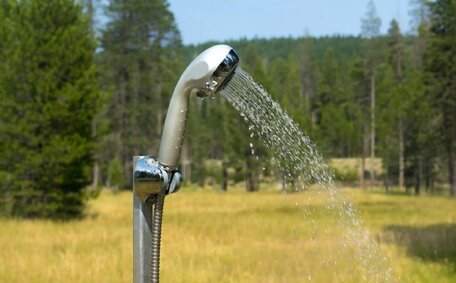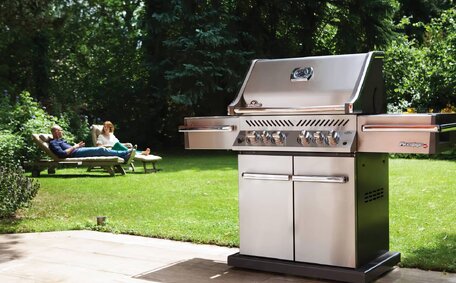Checking if Natural Gas is Available at Your Home
Start your gas line extension by verifying if natural gas is accessible at your home. Submit your address to facilitate a connection assessment.
Explore options for a new gas connection with your local energy retailer.
Many gas companies provide online resources to efficiently establish service availability. If natural gas is reachable, they will aid in site visits and cost estimates for the extension.
Should no natural gas infrastructure be present, enquire about a new service line, vital for high-energy appliances. Expect 30 to 90 business days for approval and construction with costs varying by proximity and line length needed.
Determining Your Gas Appliance Needs
When preparing to install gas line extensions, it’s important to assess your existing natural gas appliances and your current and future needs. This will help determine the proper scope and capacity of the new natural gas line.
Review your current gas appliances and strategise the extension needed for potential new ones. List future appliances, such as pool heaters or generators, to ascertain the correct line size based on gas load demands.
An upgrade may be required for multiple high-demand appliances or if existing pipelines are inadequate. Proper sizing ensures safety, appliance efficiency, and allows for future expansion.
Our specialists impart knowledge so you can learn more about expanding your gas system to fit the needs when you choose your gas appliances during your site inspection. Precise measurements are essential to ensure the gas pipes fit your immediate and future domestic needs.
Hiring a Licensed Contractor for Installation
When aiming to install a new gas line or augment an existing gas line, it is essential to engage a licensed and experienced contractor. Attempting DIY gas line work risks leaks, explosions, carbon monoxide poisoning, fines, and voiding home insurance policies if not done to code.
Only qualified tradespeople like licenced plumbers, HVAC technicians, and gas fitters can install gas infrastructure and possess the expertise necessary for safely routing, sizing, pressure testing, and ensuring safe installation. They comply with strict standards for materials, ventilation, and emergency shutoff mechanisms, ensuring a secure connection to your home.
When selecting a contractor to install gas lines, contact your local regulatory bodies to verify they are licenced for gas work in your state, insured, bonded, background checked, and hold a sound reputation. Established businesses like Peakhurst Plumbing instil confidence thanks to our 30+ years of 5-star domestic and commercial plumbing experience, gas compliance certification, and team of fully licenced and insured experts.
Peakhurst Plumbing responds to your question, 'do I need a professional for gas line extensions?', with a resounding 'Yes’, so call us for dependable, premium installations for residences and businesses throughout Sydney. Call us for obligation-free quotes, professional advice, responsive service, transparent pricing, and peace of mind on your next gas project.
The Gas Line Installation Process
Installing a gas line requires skilled professionals to guarantee safety and adherence to regulations, with a process that includes defined stages and pre-excavation safety checks:
- Measuring and Layout - Survey the area to determine the optimal route and meter location for the new gas line, improving installation efficiency. The layout ensures adequate ventilation, clearance from other utilities, and access to appliances.
- Line Installation - Trenches are dug in line with the agreed layout to place the steel pipe and polyethylene gas pipes, adhering to 'dial before dig’ procedures. Proper grades are adhered to for pressure and drainage.
- System Testing - Pressure tests check for leaks using specialised equipment. A non-hazardous gas mixture fills the pipes at high pressure to reveal any weak joints.
- Purging - The test gas mixture is cleared out by the utility company, with natural gas back filling the pipes.
- Meter Installation - The utility company gets the gas line meter installed to measure usage after establishing the gas connection that will serve your household.
- Appliance Hook Ups - Technicians factor in pilot lights when they integrate all existing and new gas appliances, discerning where your gas line should feed your gas stove and heaters, with a premium hose to your distribution pipes.
- Inspection - Authorities conduct a final review of safety procedures, pressure tests, piping codes etc to certify the gas installation.
Our proficient Peakhurst Plumbing crew can execute new gas line installations, overseeing the entire operation from the moment we receive your inquiry, inclusive of all mandatory documentation and inspections. We ensure your gas line project meets the highest quality and safety standards.
Obtaining Permits and Complying with Codes
Acquiring permits from the local council is often necessary before installing or extending a gas line. Regulations and permit application processes can vary depending on your council, so verify requirements for your area.
As the property owner, ensuring that your gas line is connected safely is paramount, thus you will likely need to submit the permit application including details of the proposed gas project like:
- Contractor information
- Equipment being installed
- Site plans showing location
- Documentation of compliance with relevant standards
It is crucial your gas installation follows all applicable national and state gas codes. These codifications delineate correct design, arrangements, piping, venting, devices and protection systems such as shutoff valve locations, buffer zones, and integrating leak surveillance into your gas infrastructure. Using licenced technicians ensures work meets the Australian Standard (AS 5601) for gas installations, including proper gas valve placements.
Following installation, authorities will inspect gas lines to issue compliance certificates permitting connection by utility companies. Owners must arrange periodic safety checks and line maintenance in line with regulations to keep certification valid.
Peakhurst Plumbing handles the entire permitting and compliance process for you. Our gas work meets required codes and standards for safe, legal, and worry-free gas line extensions or alterations.
Implementing Safety Measures
When you go ahead with extending gas lines, safety must be the top priority. Taking the necessary precautions and following correct procedures are vital when extending your gas lines to prevent leaks, explosions, and disasters.
During installation, ensure you turn off gas at the main valves and isolate the working area. Make sure to utilise gas detection instruments to surveil for any leaks after the gas shut off procedure and ensure proper worksite aeration. Appropriate personal protective equipment like gloves, goggles, ear and head protection can be used and must be worn.
Carefully apply pipe dope and Teflon tape to pipes and fixtures to avoid damage and ensure test pressures surpass regulatory requirements. For your safety, always double-check the connections of your gas pipes before you turn the gas off and proceed with reactivating the supply.
Schedule appropriate safety inspections. Authorities will check pipe joints, appliances, pressure levels and ventilation to certify safety compliance before the gas system becomes operational. Maintaining safe operation can be done using periodic testing on your own.
As your local plumbing experts since 1990, Peakhurst Plumbing implements proven safe installation procedures and materials to line your house with all gas line jobs. We take safety seriously, showing you how to extend your gas system so you can enjoy the benefits of gas appliances with confidence and peace of mind.
Inspecting and Testing the New Gas Line
Once a gas line installation in your new home is complete, it is crucial to have thorough inspections and testing conducted before use. This certification process, in coordination with your chosen energy retailer, ensures all work meets the required codes and standards for safe operation.
Professionals will first visually inspect the routing, fittings, joints, appliances and ventilation, and you’ll need to ensure your natural gas system is installed for compliance. Then a series of stringent tests detect leaks and confirm system integrity:
- Pressure testing involves using a leak detector and filling the pipes with an inert gas mixture to find out what the pressure levels are under higher than normal operating pressures. Experts then examine joints for leaks using gas detectors.
- A standing pressure test is conducted over time to check if the test pressures drop, indicating a slow leak.
- Finally, the system undergoes a purge where the test gas is flushed out by the utility company and replaced with natural gas.
Certified gas fitters document all test results for authorities to review and approve. Once the gas line passes these quality and safety inspections, the utility can connect your gas metre and activate the gas supply. Periodic compliance testing may still be needed depending on local codes.
Peakhurst Plumbing handles complete commissioning and certification to get your new gas lines safely up and running. Contact us today for professional installations and peace of mind.
Restoring Your Property After Installation
After the gas line installation, property restoration is typically necessary. This encompasses refilling any trenches where the gas line was installed and mending damage to landscaping, including gardens, plants, or lawn areas.
Technicians ought to level trenches again and incorporate new soil, reposition turf, swap plants or reapply mulch to seamlessly turn out as consistent with the surrounding area. Pathways, driveways or walls impacted by the gas line work should also be patched up and repaired as close to original condition as possible.
For indoor gas lines, temporary flooring gets replaced, surfaces repaired from access holes cut to route pipes, and new penetration fireproof seals installed. Walls, finishings and fittings will be restored to near normal looks, ready for appliance hook ups.
Please note, you should inspect all restoration work and tidy up the job site once contractors leave. Monitor for uneven soil settlement over trenches and request repair gas line services if issues arise that affect aesthetics or property access.
Peakhurst Plumbing’s gas line installations have the distinctive quality of minimising property disturbance on its own. Our teams take care to fully restore your home or business surroundings once our work is safely completed to your satisfaction.
Benefiting from Your New Gas Line
Installing a new gas line to power your appliances or extending an existing one provides many valuable benefits for your home.
Connecting additional gas appliances to service your whole house is easier with a gas line of adequate capacity. Add gas lines to new areas like your garage without worry by upgrading pipe sizing. Enjoy more design freedom and energy efficiency with access to the latest gas water heaters, cooktops, pools/spa heaters and more.
Natural gas can be used for heating hot water systems and may prove to be more efficient, trimming electricity costs significantly. Households that adapt their ovens, dryers, fires and hot water systems to gas can save money, often less than the amount spent on electricity bills. Gas fuel also lasts longer - hot water systems easily reach over 10 years service compared to 5-8 from electric.
Further perks include; enabling home backup generators, added resale value, and avoiding peak rate costs or solar intermittency problems down the track.
Peakhurst Plumbing offers secure gas line extensions, enhancing homes with the comfort and cost-saving benefits of natural gas appliances. Discuss your requirements with us today.





